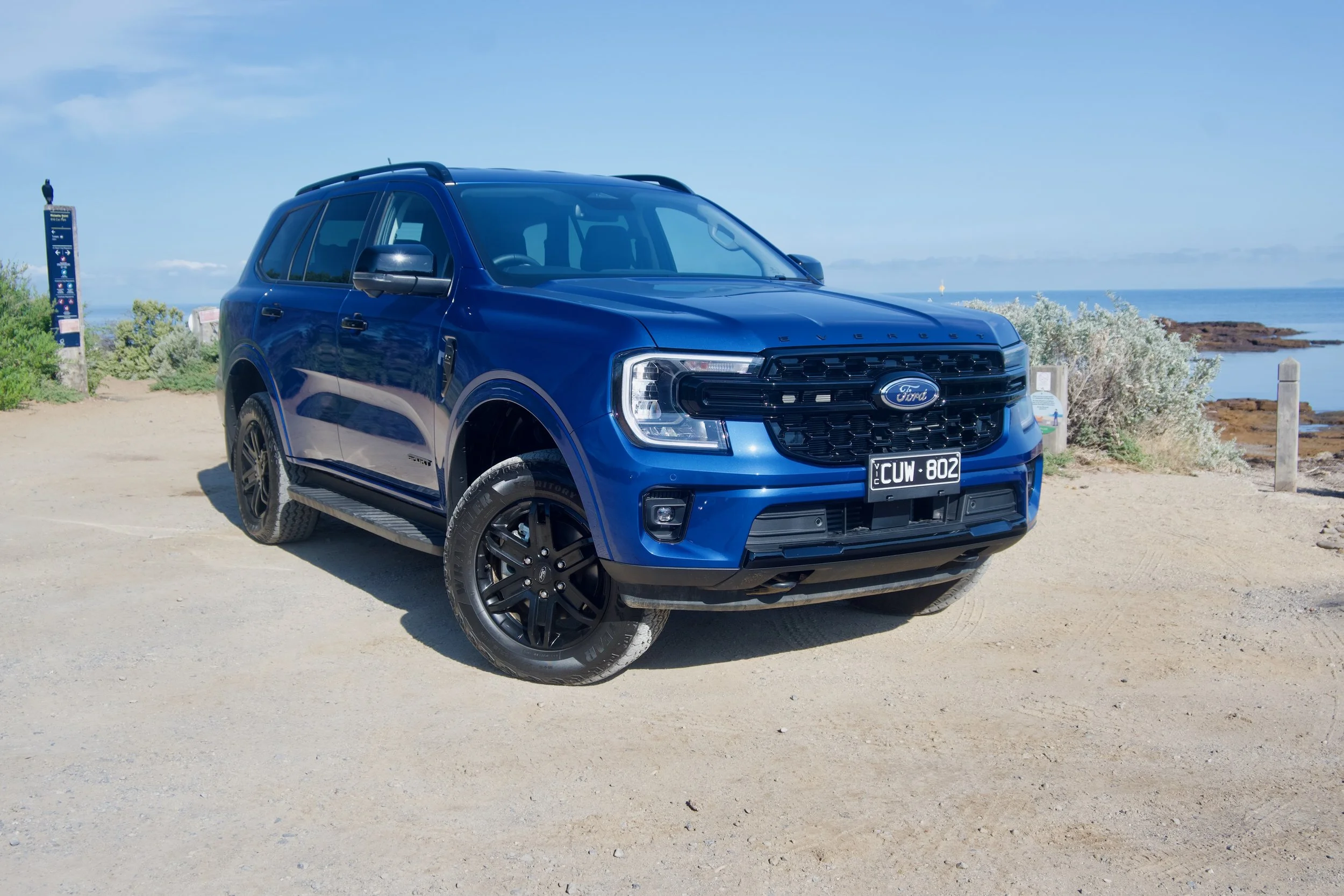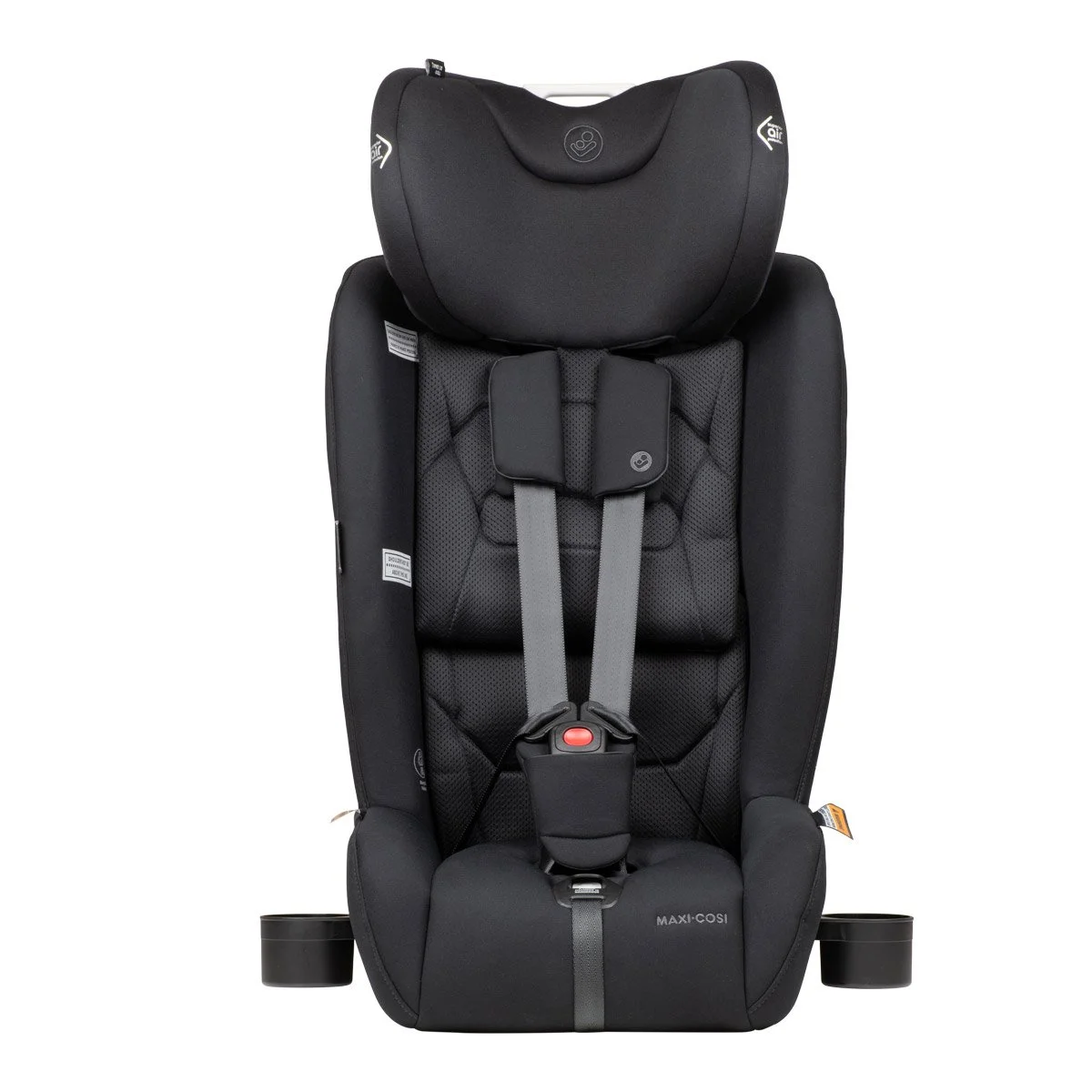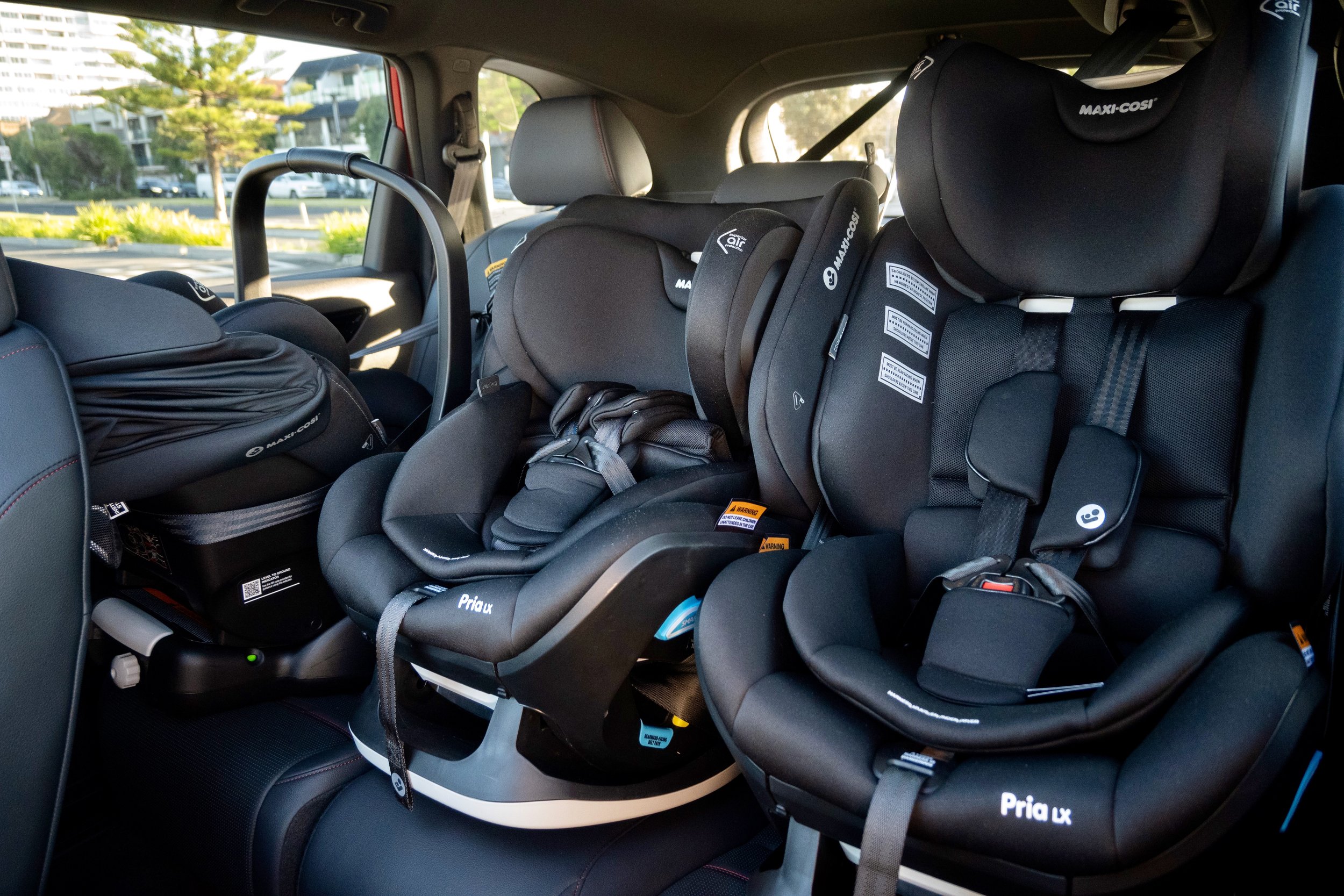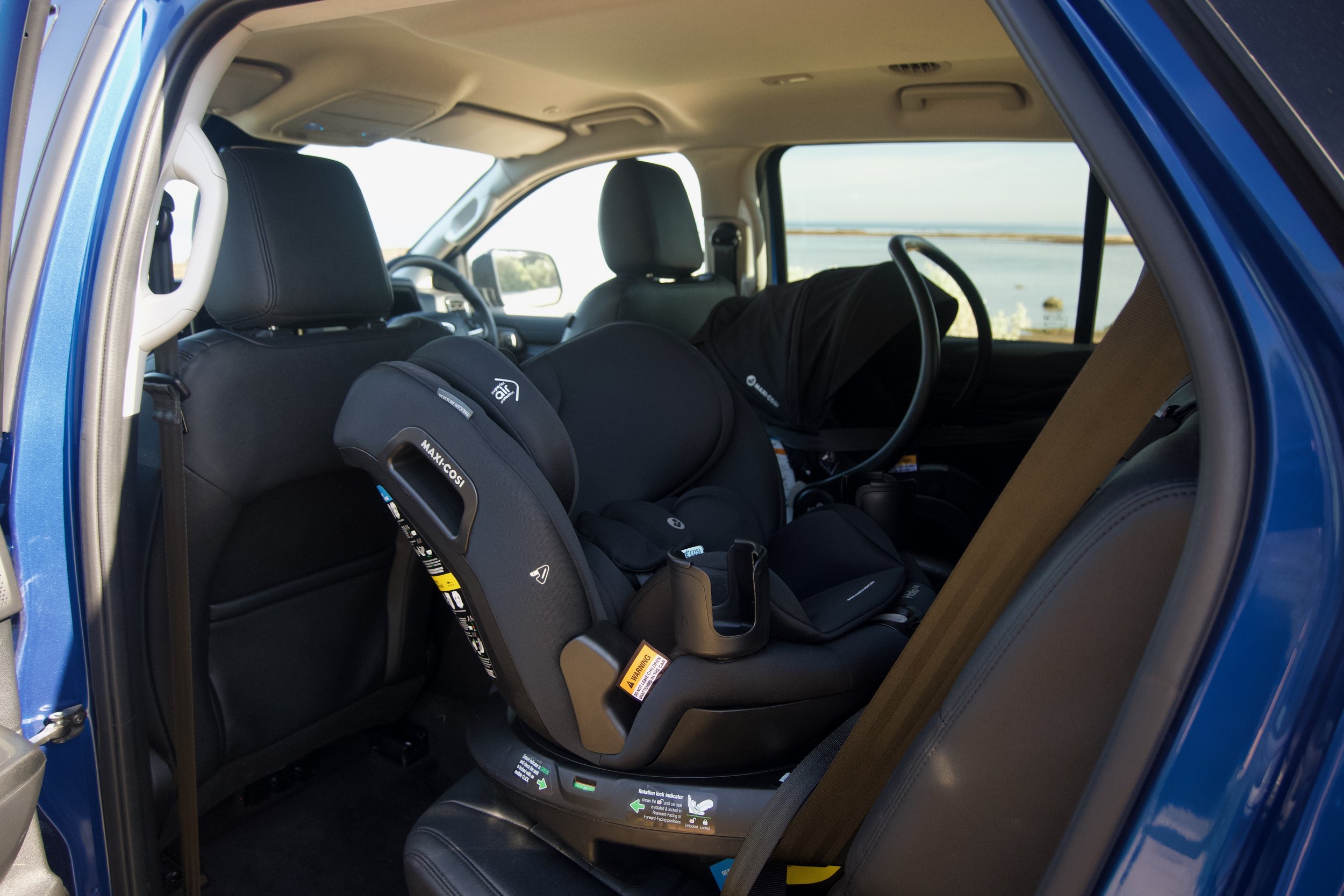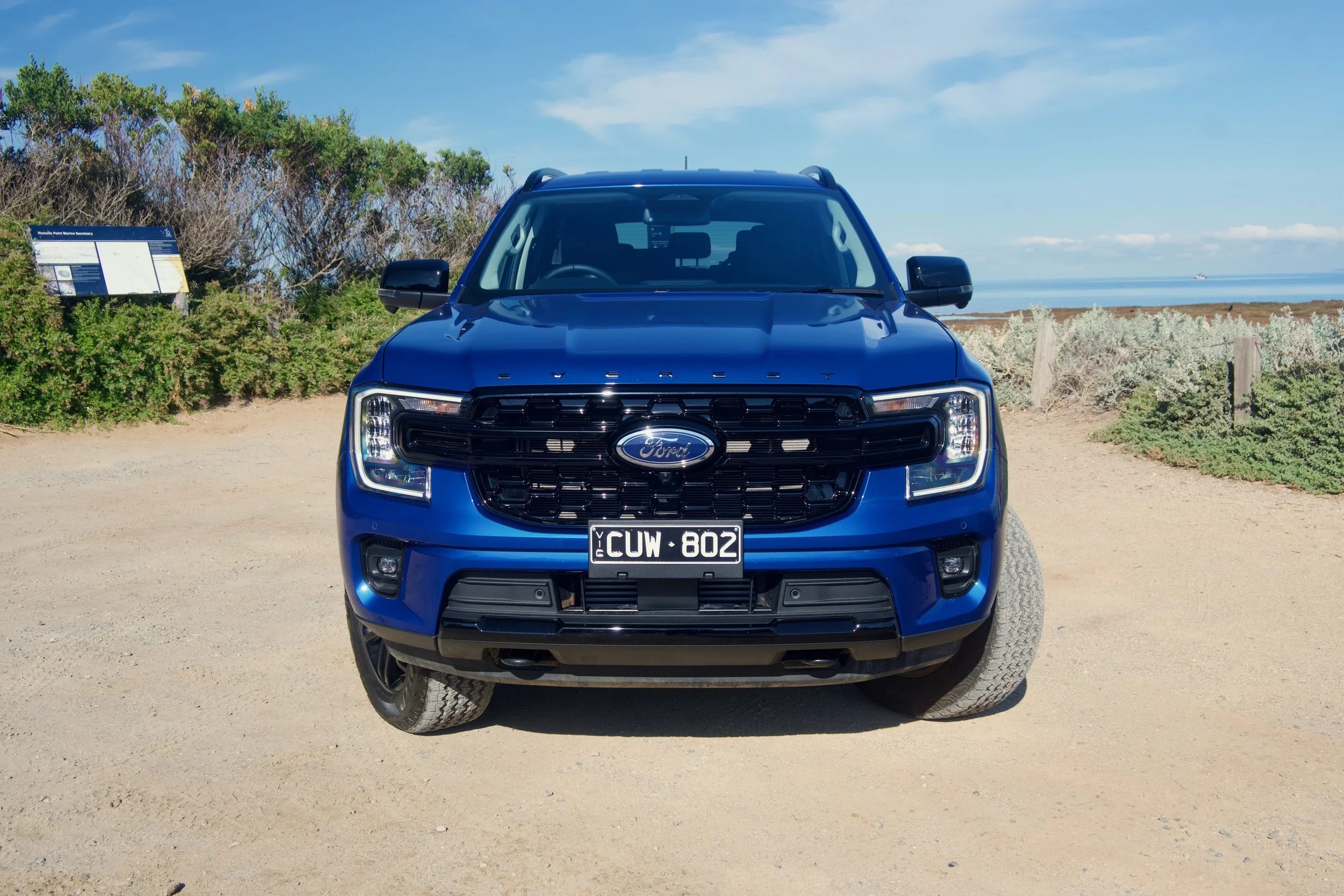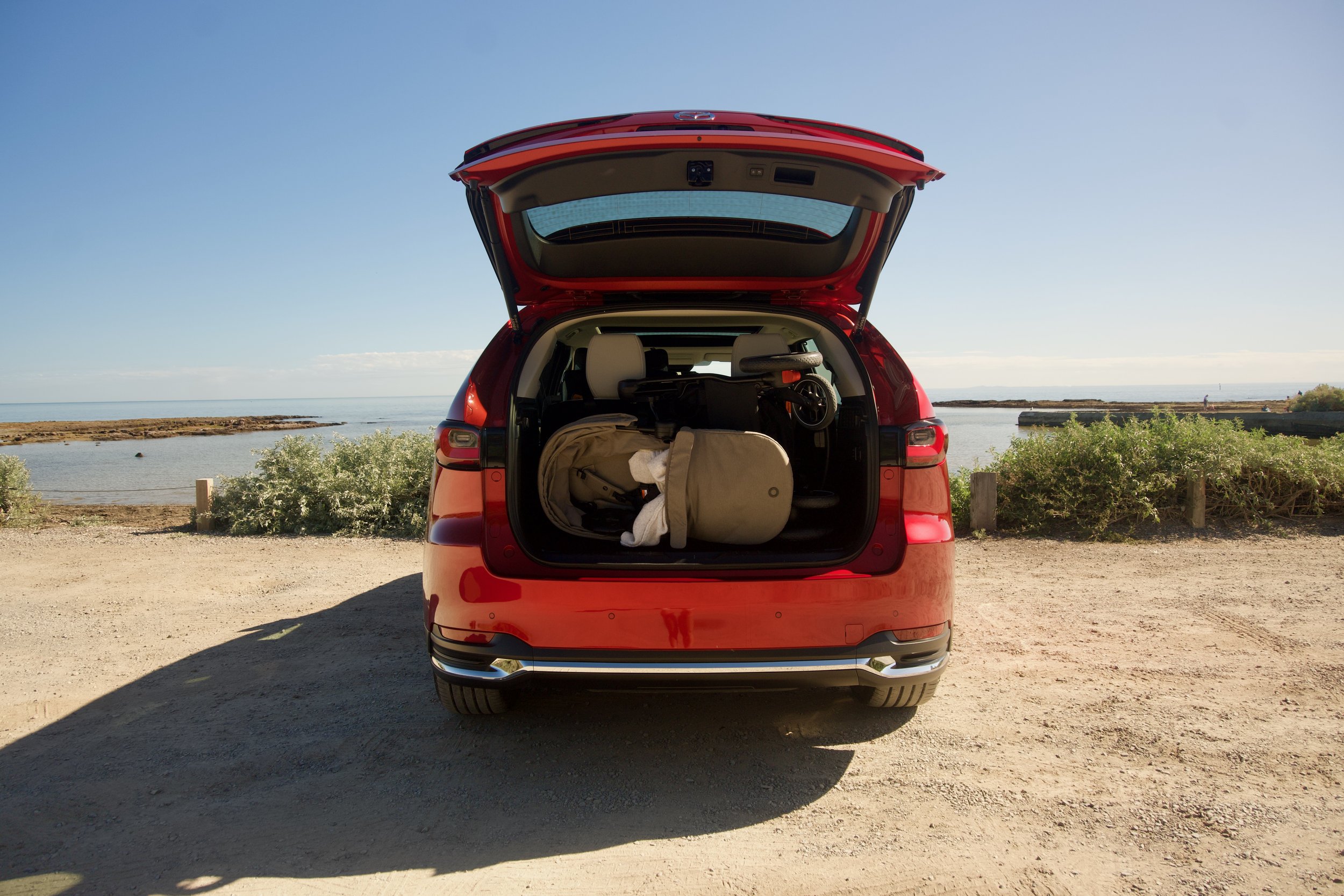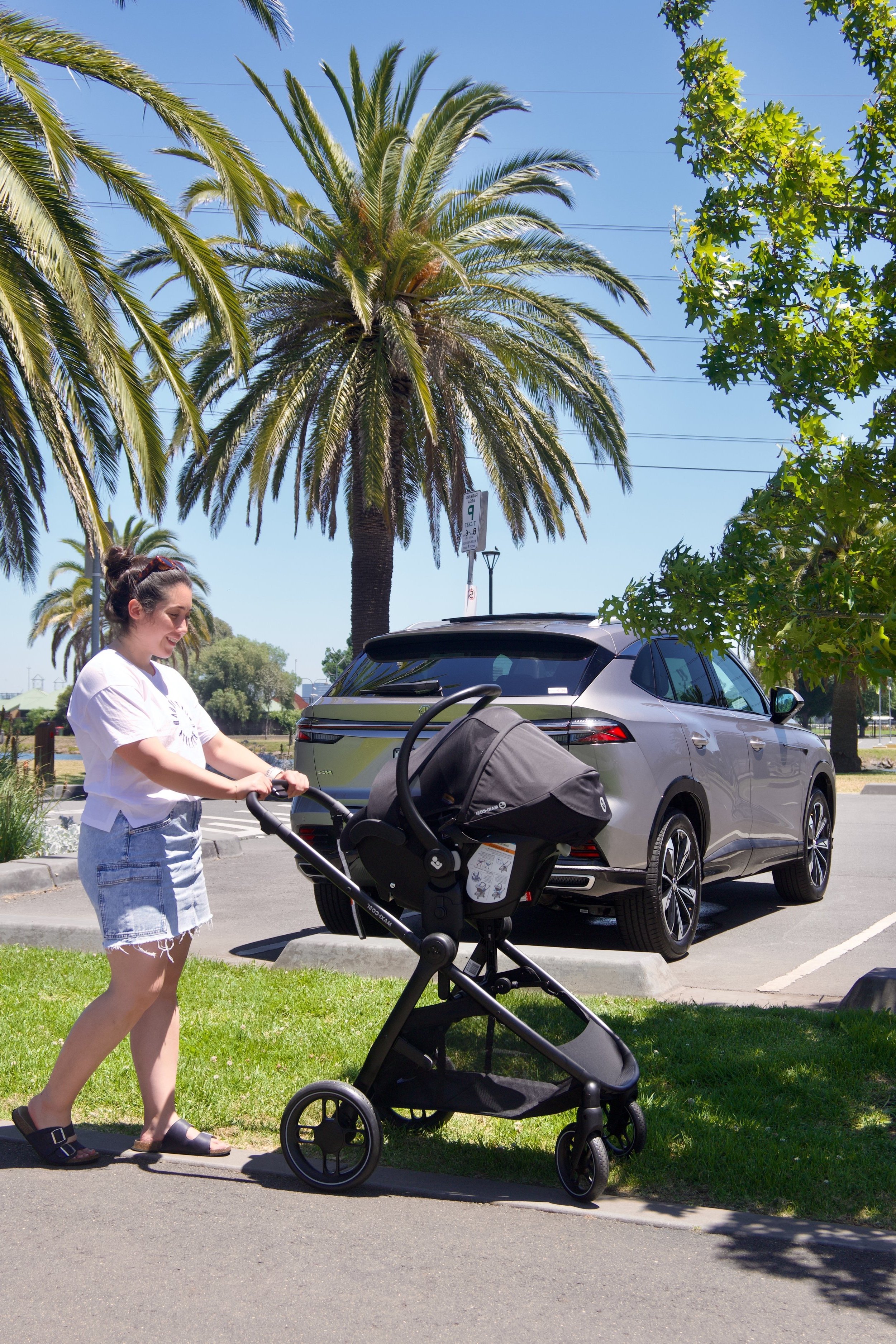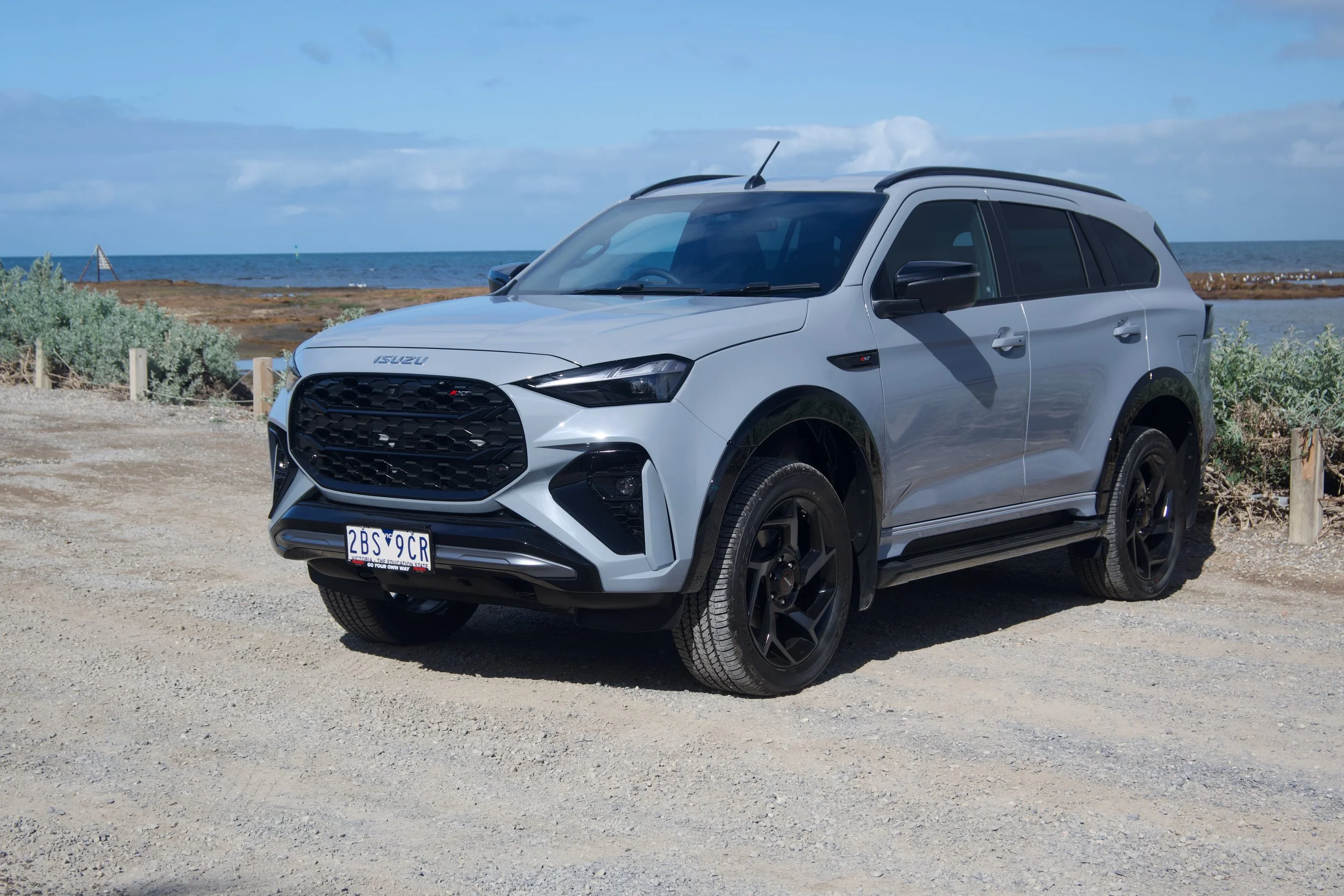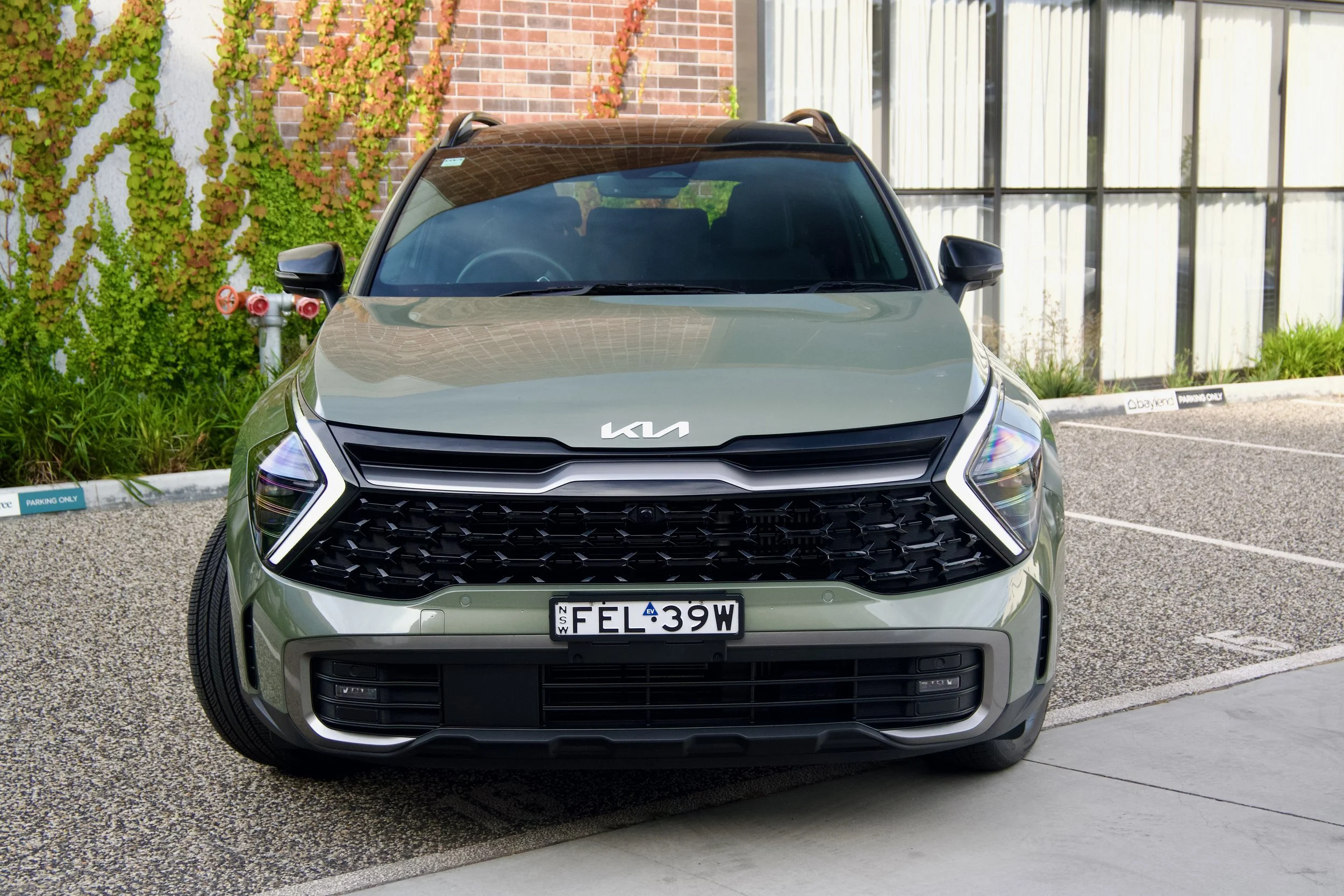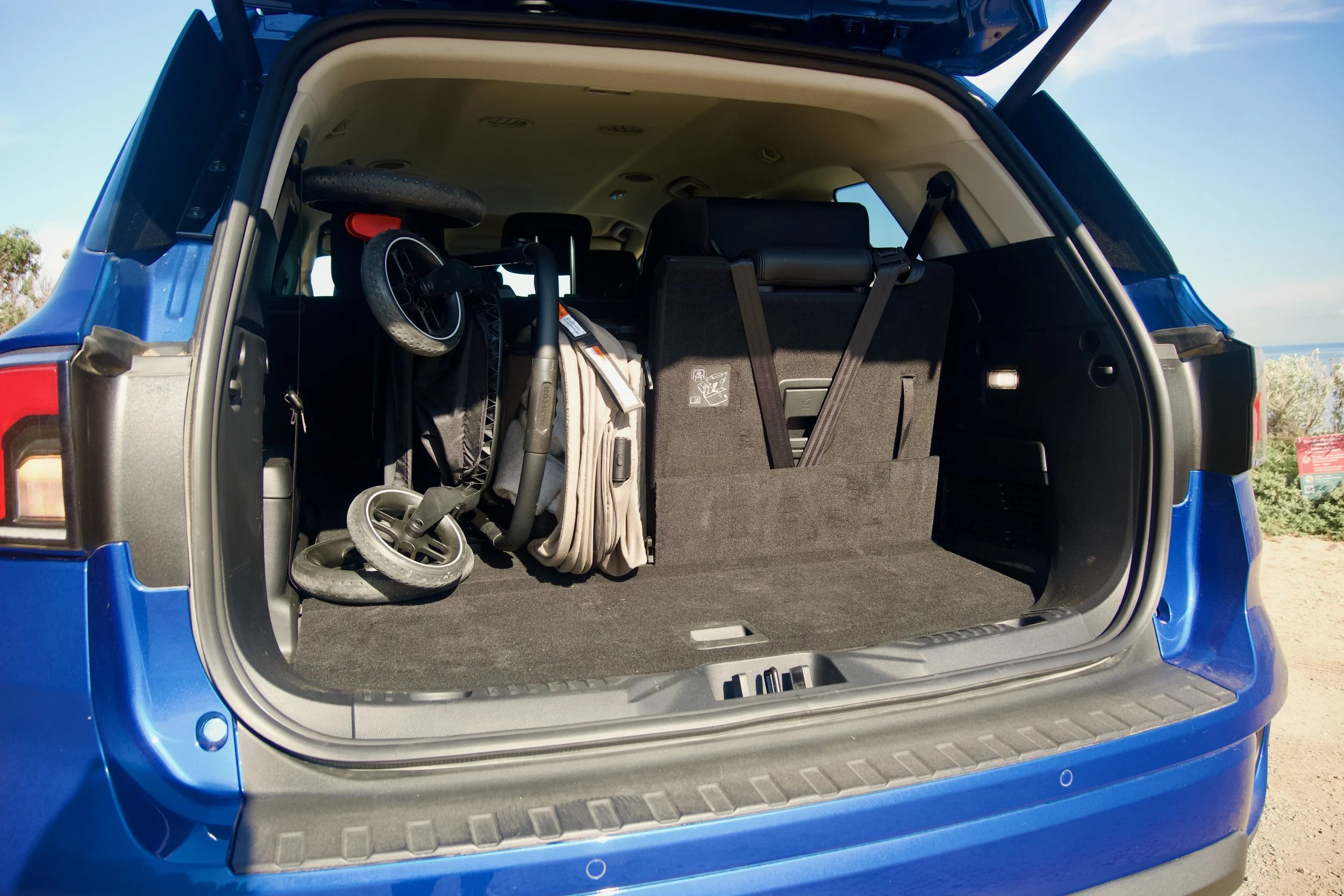2025 Ford Everest family review: Why is it one of Australia’s best-selling 7-seaters?
These days, large 7-seat SUVs like the Ford Everest are becoming go-to family cars for those who need more than space, towing and hybrid efficiency.
Whether you're installing multiple car seats, planning for a large family or looking for an excuse to take your household on a road trip, having that extra row of seats and more usable space makes a big difference.
This Ford Everest Sport 4WD family review will look through the lens of a practical parenting perspective. If you're about to welcome your second or third child, or you're just ready for a bigger, more capable SUV, you might be wondering: Does the Everest actually make family life easier?
The Everest is packed with family-friendly features like five top tether points, a usable third row, and thoughtful touches like rear air vents, USB charging across all rows, and a big 12-inch touchscreen for the front passenger and driver.
We’re especially looking at how it handles car seat installation, how much space you really get in the boot with a pram, and whether it’s a good fit for families who want something bigger, safer, and more versatile for the long term — even if off-roading or towing aren’t on the weekly agenda.
Did you know Baby and Car uses a trusted network of dealerships Australia-wide to find you the best price for your next brand new car? With tailored Australian-based support, enquire today. Find out more here.
Ford Everest Pros & Cons: What you should know before buying
Pros:
Flexible with child seat configurations: With 5 top tether points, it’s offers a range of different configurations
Fits three across with ease: Three car seats fit in the middle row including a baby capsule. Halo 360 featured in images removed and swapped for 2x Maxi Cosi Pria LX seats.
Boot space still works with all 7 seats up: Despite the limited space, we were able to fit a full size Maxi Cosi Mali stroller.
USB ports and cup holders in all three rows: Good to keep the kids hydrated and entertained on long trips
360 degree view camera on the Sport: Usually reversed for the high grade trims on legacy brand models
V6 turbo diesel with 3,500kg towing capacity: Works just has hard as a ute but with the flexibility of 7 seats.
Cons:
Second-row seatbelt placement limits third-row access: If you have a child seat using a seat belt install in the second row you won’t be able to pull the seat forward to back without having the seat belt in the way
Fuel consumption averaged 11.5L/100km (no hybrid option): Not as great as some of the hybrid 7-seater options
Sport model has Manual folding third row (not powered): While a nice to have feature it limits children as the seat could be too heavy to move.
No built-in window shades: Again another nice to have but something other 7 seater competitors have.
Value for money: Pricing for the Sport V6 4WD as tested is $75,540 before on-road costs
Need a car seat installed? We’re here to help…
Ford Everest price guide – How much does the 2025 Ford Everest cost?
The Ford Everest is available in seven trim levels, and two drivetrain options: 2WD and AWD, pricing as follows:
2025 Ford Everest Ambiente Auto RWD bi-turbo: $54,490 before on-road costs
2025 Ford Everest Ambiente Auto 4WD bi-turbo: $59,490 before on-road costs
2025 Ford Everest Sport Auto RWD bi-turbo: $63,990 before on-road costs
2025 Ford Everest Trend Auto 4WD bi-turbo: $67,290 before on-road costs
2025 Ford Everest Black Edition Auto 4WD bi-turbo: $69,000 before on-road costs
2025 Ford Everest Sport Auto 4WD V6: $75,540 before on-road costs (as tested)
2025 Ford Everest Tremor Auto 4WD V6: $76,590 before on-road costs
2025 Ford Everest Wildtrak Auto 4WD V6: $77,490 before on-road costs
2025 Ford Everest Platinum Auto 4WD V6: $82,390 before on-road costs
(Exact driveway pricing will vary depending on location and registration type; check with Ford Australia or your local dealership for up-to-date costs.)
Want to save money? Baby and Car uses a trusted network of dealerships Australia-wide to find you the best price for your next brand new car. With tailored Australian-based support, it’s free to get a quote. Find out more here.
Ford Everest engine options: Diesel
The 2025 Ford Everest comes with two engine and two drivetrain options:
Bi-turbo: 2.0L 4-cylinder turbo diesel - 154kW of combined power & 500 Nm of torque
V6: 3.0L V6 turbo diesel - 184kW of combined power & 600 Nm of torque
The Bi-Turbo is available in both 2WD and 4WD whereas the V6 engine is 4x4 only.
The 2025 Ford Everest is available with two diesel engine options — both delivering solid performance in regards to torque figures especially, I would say driving comfort my preference is with the V6.
We tested the V6 3.0L turbo diesel in the Everest Sport 4WD, and it delivered in all the areas we were looking for. A freeway speed up entry, a school drop off and long-distance travel. With 184kW of power and 600Nm of torque, it’s the strongest engine offerings in a 7-seater 4x4 SUV under $80,000 in Australia – comparing Toyota LandCruiser Prado, Mitsubishi Pajero Sport, LDV D90, Isuzu MU-X, and the Toyota Fortuner.
The power delivery felt smooth and responsive, with no extremely noticeable lag, even from a standing start owed to the well-calibrated auto stop/start function.
If you’re looking for a family SUV that can tow confidently, the V6 based on paper alone would be my pick let alone after driving it, it shares the same engine with the Ford Ranger, and we’ve towed with that before without issue. While we didn’t tow with the Everest during testing this time, but we’re confident that the 3,500kg braked towing capacity would be well supported by this engine.
I would suggest when towing or carrying full loads with any car, to keep an eye on your gross combination mass(GCM) and gross vehicle mass(GVM). Based on some rough calculations you shouldn’t run into many issues for a weekend or week long trip with small children in the Everest but depending on what and how much you pack this can creep up. For reference the Tare Mass is 2408kg for the Sport, GVM is 3150kg and GCM is 6250kg.
It’s worth noting that while this V6 diesel SUV isn’t the quietest option out there — especially compared to a petrol hybrid — it’s far from harsh. The cabin stays relatively insulated from engine noise, and for most families, it’ll be a comfortable daily driver.
Check out other Baby and Car content:
Is the Ford Everest fuel-efficient?
The 2025 Ford Everest offers two diesel engine options, and with them, two different official fuel consumption figures:
2.0L Bi-Turbo Diesel: 7.2L/100km (combined)
3.0L V6 Turbo Diesel: 8.5L/100km (combined)
During our real-world test of the Everest Sport V6 4WD, we averaged 11.3L/100km over a mix of city and highway driving. That figure is higher than expected, especially for families comparing this large SUV against rivals in the same segment. For context:
Isuzu MU-X (3.0L diesel): 8.3L/100km
Mitsubishi Pajero Sport (2.4L diesel): 8.0L/100km
Toyota Prado (Diesel Hybrid): 7.6L/100km
Nissan Patrol V8 (Petrol): 14.4L/100km
So where does the Everest sit? It's less efficient than diesel competitors like the MU-X or Pajero Sport, and while it’s still far more frugal than a V8 Patrol, we’d like to see it come closer to its claimed 8.5L/100km — especially without any towing involved.
We’ll be reviewing the Everest Platinum later this year, and we’re keen to test fuel consumption over a longer distance to see how it performs with more kilometres under its belt.
Something worth mentioning, the Ford Everest requires AdBlue, a diesel exhaust fluid used to reduce emissions. While we didn’t need to top it up during our test, it’s an important part of ongoing maintenance. It’s not a huge cost or frequent job, but it’s one more thing for busy families to stay on top of — especially if you're new to diesel SUVs. Don’t worry like your fuel gauge it will alert you when it’s low and time to fill up. You can buy it in large bottles or fill up at selected fuel stations.
Ford Everest Interior & Space: How practical is it for families?
Inside the 2025 Ford Everest Sport 4WD, the cabin immediately feels like a step up from your average family SUV.
The leather-accented seats and heated front seats add a premium touch without needing to spend more money on the higher grades. While the 12-inch infotainment display with wireless Apple CarPlay is central to the Everest’s family-friendly tech package, for families who spend hours in the car every week, the Everest’s dashboard strikes a solid balance between looking nice and everyday practicality.
Up front, storage is sorted with a spacious centre console big enough for essentials like wipes, hand sanitiser, wallets, and snacks, while the door bins offer good-sized bottle holders and extra room for odds and ends. The Everest is one of the few 7-seater SUVs in Australia that offers true flexibility for five kids in car seats.
We fitted a Maxi-Cosi Halo 360 swivel seat in the second row and found that, while three across is possible, bulky car seats can make third-row access difficult — particularly if you’re relying on seatbelt-installed child seats rather than ISOFIX. The second row does slide and recline, but space becomes limited when rear-facing car seats are installed and the third row is also in use. It’s worth noting there is a 60/40 split in the second row.
For families with toddlers and older kids, there’s enough room to make it work, but you’ll need to plan ahead. Kids will be comfortable in all three rows, with rear air vents mounted in the ceiling and USB charging access available within the cabin. The third row is best suited for younger children rather than adults if you’ve got rear-facing car seats installed in the second row.
While legroom is tighter in the third row, it’s still practical for school runs and smaller humans. The Everest’s cabin materials are well suited to busy families, with leather upholstery that easily wipe clean and hard-wearing plastics where needed — like the surrounds of the centre console and door sills.
Visibility from the driver’s seat is generally good, although with the third row in use and a pram standing upright in the boot, the rear view can be partly obstructed. A digital rear-view mirror would’ve been a nice touch here, but isn’t expected from Ford as non of their other models and variants offer this feature. Overall, the Everest Sport’s interior delivers a strong mix of tech, comfort, and flexibility, making it one of the most family-ready 7-seat diesel SUVs currently available in Australia.
Want to save money? Baby and Car uses a trusted network of dealerships Australia-wide to find you the best price for your next brand new car. With tailored Australian-based support, it’s free to get a quote. Find out more here.
Ford Everest Boot Space & Storage: How much can it fit?
With 5 seats up: 898L
With 7 seats up: 259L
The 2025 Ford Everest Sport 4WD has one of the most practical and spacious boots in the large SUV category. With five seats in use, there’s a massive 898 litres of boot space. That’s more than enough room for a full-size pram or double pram, sports gear, school bags, a week’s worth of groceries.
When all seven seats are in use, you still get 259 litres of storage in the boot — which is better than the Toyota Landcruiser Prado and Mitsubishi Pajero Sport 7-seater SUVs in Australia.
We were able to stand up a Maxi-Cosi Mali stroller and still fit 1–2 shopping bags, which is impressive given the limited space in most SUVs when all three rows are upright. That said, if you rely on a bulky travel system pram, you might need to choose between taking that or a full grocery load. A compact stroller is a much better fit when the third row is in use.
One of the Everest Sport’s most family-friendly features is the power tailgate, which made it easy to open and close the boot hands-free — especially helpful when wrangling kids and gear. There’s also a handy underfloor storage compartment to stash smaller items like wipes, snacks, or emergency gear, keeping the main cargo area tidy.
Installing car seats is easier in the Everest thanks to the top tether anchor points on the seat backs of both the second and third rows. This layout makes it simple to follow the correct installation order — we found starting with the third row, then moving forward made it light work. The boot opening is wide and at a reasonable height, so lifting prams or heavier items in and out isn’t a struggle.
Overall, the Ford Everest boot space is one of the most usable in the segment both 5 and 7 seat configurations. Whether you’re using it as a full-time family car, loading it up for holidays, or just managing the school run, the Everest delivers practicality where it counts — with space, smart storage, and thoughtful family-focused features.
In the market for a new car? Get one on one support with Baby and Car
Ford Everest Safety Features: Is it a safe family car?
The 2025 Ford Everest comes with a comprehensive suite of active safety features and advanced driver assistance systems, with many key technologies included as standard even in the entry-level Ambiente. Ford has equipped the entire Everest range with safety tech like autonomous emergency braking, adaptive cruise control, lane-keeping aid, and blind-spot monitoring, making it a safety-focused 7-seater SUV for families.
Standard across the whole range is the following safety features:
Autonomous emergency braking (AEB) with pedestrian, cyclist & junction assist
Reverse brake assist
Lane-keeping aid with lane departure warning
Blind spot monitoring with rear cross-traffic alert
Rear view camera
Front and rear parking sensors
Traffic sign recognition
Post-collision braking
Evasive steer assist
Driver impairment monitor
Adaptive cruise control with stop & go and lane centring
Speed sign recognition with intelligent speed assist
Electronic stability control (ESC) and traction control
Seven airbags (dual front, side, curtain, driver’s knee)
ISOFIX anchor points on outboard second-row seats
Top tether points: 5 in 7-seat variants, 3 in 5-seat variant
Hill launch assist & hill descent control
Tremor adds:
Tyre pressure monitoring system
Platinum adds:
360 degree view camera (package available on other models)
ANCAP safety rating: The 2025 Ford Everest holds a 5-star ANCAP safety rating across the range.
Standard across all variants — from the base Ambiente to the top-spec Platinum — is a suite of active safety features and driver assistance technology. This includes autonomous emergency braking (AEB) with pedestrian, cyclist and junction assist, adaptive cruise control with lane centring, lane-keeping aid, rear cross-traffic alert, and blind spot monitoring. You’d be forgiven for not knowing what most of them do but comforted knowing they will keep you safe on the road from oncoming hazards.
There’s also reverse brake assist, seven airbags, ISOFIX and top tether anchor points, as well as hill descent control.
From a real-world perspective, everything worked as expected during testing. The 360 view camera (which was part of the touring pack) and parking sensors were particularly useful in school carparks and tight driveways, while the alerts and warnings were clear without being overwhelming. In the Sport trim, features like adaptive cruise control and lane guidance added confidence on the highway and in heavy traffic.
Higher trims like the Platinum adds features like a 360-degree camera and tyre pressure monitoring (also included on the Tremor) as standard, but there’s no major safety compromise even at entry level.
Want to save money? Baby and Car uses a trusted network of dealerships Australia-wide to find you the best price for your next brand new car. With tailored Australian-based support, it’s free to get a quote. Find out more here.
Toyota LandCrusier Prado vs Ford Everest vs Isuzu MU-X: which one is best for families?
Best for Fuel Efficiency: Ford Everest bi-turbo (7.2L/100km)
Best for Cargo Space: Isuzu MU-X (311L with the third row up)
Best for Luxury & Comfort: Ford Everest Platinum
Best for Towing: All 3.5 tonne
Most affordable to service: Toyota LandCruiser Prado ($390 per service for 10 years)
Longest warranty: Isuzu Ute Australia (6 years unlimited km)
Check out other Baby and Car reviews:
Should You Buy the Ford Everest in 2025? Final verdict
The 2025 Ford Everest Sport 4WD stands out as one of the most complete 7-seater SUVs for families in Australia. It’s not perfect but comes bloody close.
It’s one of the few large SUVs that combines family practicality with a tough, capable platform that still feels refined on the road. With five top tether points and two ISOFIX anchor points, the Everest makes installing child seats a lot easier and more versatile.
Boot space in the Ford Everest is excellent in five-seat mode, with 898L of cargo space, making it ideal for family road trips, sports days, or just loading up with a pram, groceries, and bags. Even with all 7 seats in use, you still get 259L of boot space, which is usable for a compact stroller and shopping — something that can’t be said for every SUV in this segment.
The power tailgate, underfloor storage, and third-row seat back tethers add everyday convenience in a third row for parents juggling more than three kids.
Under the bonnet, the 3.0L V6 turbo diesel delivers 184kW and 600Nm of torque, giving the Everest enough power to tow up to 3.5 tonnes comfortably. It feels smooth and strong, with a responsive stop/start system and very little lag — a great option if you're towing, road-tripping, or hauling a full load of passengers. However, if fuel efficiency is a key factor, the 2.0L Bi-Turbo diesel Everest offers better economy at a claimed 7.2L/100km, compared to the V6’s 8.5L/100km. In our test, we averaged 11.3L/100km in mixed driving — higher than expected, and something to keep in mind for families watching long-term fuel costs. We plan on revisiting these figures later in the year with a Platinum trim.
For those considering long-term ownership, it’s also important to note that the Ford Everest uses AdBlue, a diesel exhaust fluid that requires occasional refilling — not a deal-breaker, but worth factoring into your regular maintenance schedule.
When compared to its key rivals, the Everest holds up strongly in most areas. The Isuzu MU-X leads for boot space with 7 seats up (311L), while the Toyota Prado diesel hybrid claims better fuel efficiency at 7.6L/100km (compared to the 8.5L/100km in the V6) and too comes out on top for affordable servicing, with capped pricing at $390 per service over 10 years.
The Isuzu Ute Australia warranty remains the best out of the three with six years of unlimited-kilometre coverage. The Ford Everest is covered by five years unlimited kilometre warranty.
If you're looking for something with more premium touches, the Ford Everest Platinum offers more luxury features, including a 360 degree view camera, matrix LED headlights, and Active Park Assist — making it a serious option for buyers looking at a luxury-feel 7-seat diesel SUVs in its price range.
For most Australian families, the Everest Sport V6 4WD hits the sweet spot — offering space, safety, power, and comfort in one well-rounded package..

